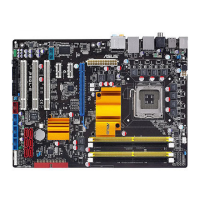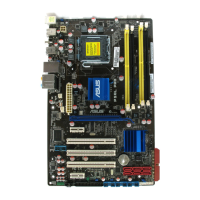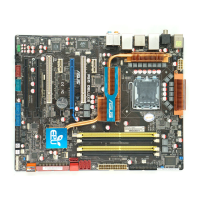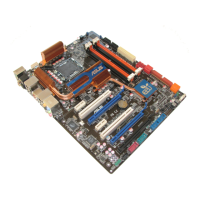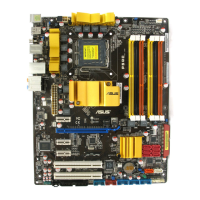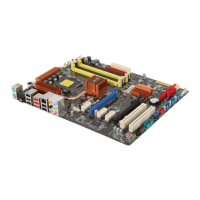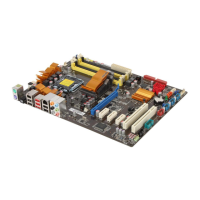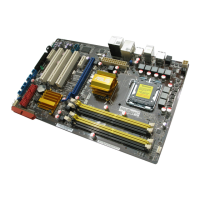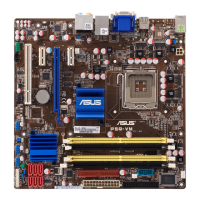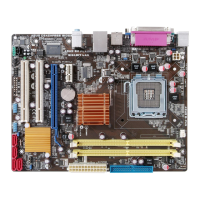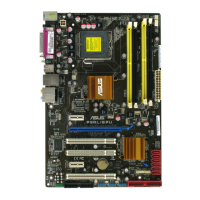
Do you have a question about the Asus P5QL/EPU - Motherboard - ATX and is the answer not in the manual?
| Brand | Asus |
|---|---|
| Model | P5QL/EPU - Motherboard - ATX |
| Category | Motherboard |
| Language | English |
Device compliance with FCC rules and regulations for radio frequency energy.
Digital apparatus compliance with Canadian radio noise emission regulations.
Precautions to prevent electrical shock hazards during system handling and component installation.
Guidelines for safe installation and operation of the motherboard and its components.
Overview of the manual's structure, detailing chapters and their content.
Information on accessing updated product information and support from the ASUS website.
Details on additional documentation that may be included with the product package.
Explanation of text formatting, symbols, and command syntax used throughout the manual.
A greeting and introduction to the ASUS P5QL/EPU motherboard and its features.
Lists the items included in the motherboard package for user verification.
Highlights key features and technologies of the motherboard.
Highlights key features and technologies of the motherboard, such as Green ASUS and CPU support.
Details unique features provided by ASUS, like AI Life and Power Saving solutions.
Describes the ASUS EPU technology for real-time power saving and performance moderation.
Features that simplify component installation, BIOS updates, and setting backups.
Features that enhance the visual appeal, like custom boot logos.
Features for tuning system performance through overclocking.
Explains the function of the standby power LED and its indication of system status.
Instructions on orienting and installing the motherboard correctly within the chassis.
Identifies the screw hole locations for securing the motherboard to the chassis.
Diagram illustrating the location of major components and connectors on the motherboard.
Lists and describes the various connectors, jumpers, and slots on the motherboard with page references.
Step-by-step guide for correctly installing a CPU into the LGA775 socket.
Instructions for mounting the CPU heatsink and fan assembly for proper thermal management.
Procedure for safely removing the CPU heatsink and fan assembly.
Introduces the DDR2 DIMM sockets and their configuration layout.
Details recommended memory module installations for single and dual-channel configurations.
Lists qualified vendors and part numbers for DDR2 1066MHz memory modules.
Lists qualified vendors and part numbers for DDR2 667MHz memory modules.
Step-by-step guide for inserting DDR2 DIMM memory modules into the motherboard sockets.
Procedure for safely removing DDR2 DIMM memory modules from the motherboard sockets.
Instructions for installing expansion cards into available motherboard slots.
Steps to configure installed expansion cards via BIOS settings and driver installation.
Describes the use of PCI slots for various expansion cards.
Details compatibility for PCI Express x1 cards like network and SCSI adapters.
Specifies support for PCI Express x16 graphics cards.
Procedure for clearing the CMOS memory to reset BIOS settings, including passwords.
Identifies and describes the function of each port on the motherboard's rear panel.
Explains the audio port functions based on the number of audio channels configured.
Details the internal connectors on the motherboard for various peripherals and drives.
Describes the connector for the floppy disk drive signal cable.
Connector for an additional S/PDIF output module for digital audio.
Connector for Ultra DMA 133/100/66 signal cables for IDE hard drives.
Connectors for Serial ATA hard disk drives, detailing connection options.
Connectors for CPU, chassis, and power supply fans, with power specifications.
Connectors for USB 2.0 ports, supporting up to 480 Mbps connection speed.
Connector for stereo audio input from sources like CD-ROM drives.
Connector for chassis-mounted front panel audio modules, supporting HD Audio or AC'97.
Connector for chassis intrusion detection sensors or switches.
Connectors for ATX power supply plugs, detailing orientation and PSU recommendations.
Connector for chassis-mounted functions like power/reset buttons and LEDs.
Guidance on installing compatible operating systems like Windows XP/Vista and driver installation.
Details the contents of the support DVD, including drivers, software, and utilities.
Overview of utilities and procedures for managing and updating the motherboard's BIOS.
Instructions for updating the BIOS using the ASUS Update utility via an internet connection.
Steps to update the BIOS using a downloaded BIOS file via the ASUS Update utility.
Guide on creating bootable floppy disks for DOS or Windows environments.
Utility for updating BIOS directly from BIOS chip using floppy or USB without DOS.
Utility for updating BIOS in DOS environment using a bootable floppy disk.
Auto-recovery tool to restore corrupted BIOS files from various media.
Overview of the BIOS setup utility interface, including menu items, bar, and fields.
Describes the main navigation items in the BIOS setup menu bar.
Explains the keys used for navigating and selecting options within the BIOS setup screens.
Explains how highlighted items in the menu bar display specific menu items.
Describes how to display sub-menus by selecting an item and pressing Enter.
Details how configurable fields are displayed and modified within the BIOS setup.
Explains the appearance and use of pop-up windows for configuration options.
Describes the function of scroll bars for navigating content that doesn't fit on screen.
Indicates where to find brief descriptions of selected items on the menu screen.
Allows setting the system's current time within the BIOS.
Allows setting the system's current date within the BIOS.
Configures the type of floppy drive installed, with options for disabled or specific sizes.
Lists SATA devices and allows access to their configuration information.
Menu for configuring SATA devices, including SATA mode and write protection.
Displays automatically detected system specifications like BIOS and CPU info.
Overview of performance settings configurable within the Ai Tweaker menu.
Table showing synchronization between Front Side Bus and CPU External Frequency.
Allows setting the operating frequency for DDR2 memory modules.
Allows adjusting the voltage supplied to the memory modules.
Allows manual adjustment or auto-setting of the North Bridge voltage.
Manually sets the FSB Termination Voltage for the CPU.
Allows setting the voltage for the South Bridge.
Allows setting an offset for the CPU's core voltage.
Enables or disables the EPU function for power management.
Displays CPU-related information and settings like CPU Ratio and C1E Support.
Enables or disables the No-Execution Page Protection Technology.
Allows using Enhanced Intel SpeedStep Technology for power management.
Enables or disables Intel C-STATE Technology for CPU idle states.
Allows configuration of advanced chipset settings, including memory and PCI remap.
Settings related to the motherboard's North Bridge chipset.
Enables or disables memory remapping for 64-bit OS.
Configures the memory hole setting.
Allows manual configuration of DRAM timing parameters for performance tuning.
Selects the primary graphics controller for the boot device.
Enables or disables onboard devices like audio, LAN, IDE, and serial/parallel ports.
Enables or disables the motherboard's High Definition Audio feature.
Sets the front panel audio connector mode to HD Audio or AC'97.
Enables or disables the onboard Gigabit Ethernet LAN controller.
Allows enabling or disabling the JMB368 IDE controller.
Selects the base address for the Serial Port1.
Selects the base address for the Parallel Port.
Configures various USB-related features, including controller modes and legacy support.
Allows configuration of advanced settings for PCI/PnP devices.
Selects the ACPI state for system suspend, determining power consumption during sleep.
Allows adding tables for ACPI 2.0 specifications.
Enables or disables ACPI support in the Advanced Programmable Interrupt Controller.
Configures Advanced Power Management settings, including AC power loss behavior and wake-up events.
Displays real-time monitoring of CPU and motherboard temperatures, fan speeds, and voltages.
Specifies the sequence of devices from which the system attempts to boot.
Configures boot-related options like Quick Boot, Full Screen Logo, and NumLock state.
Allows setting or changing the supervisor password for BIOS access.
Selects the level of access restriction for users to BIOS setup items.
Allows setting or changing a user password for limited BIOS access.
Utility for running the ASUS EZ Flash 2 BIOS update tool.
Enables or disables the ASUS Express Gate instant-on environment.
Enables or disables checking of the Realtek LAN cable during POST.
Utility to save, load, and manage BIOS overclocking profiles.
